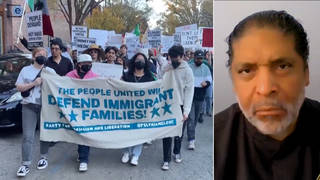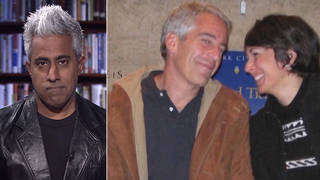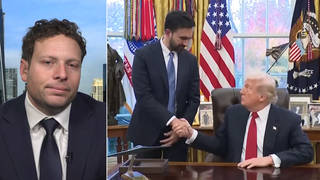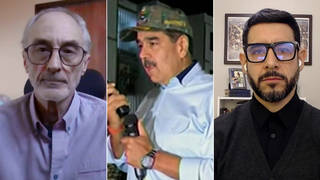
Guests
- Jaime Snyderfilmmaker and co-founder of the Buckminster Fuller Institute. He is Buckminster Fuller’s grandson and studied and worked with him until his passing in 1983.
- Dr. John Toddrenowned biologist and pioneer in the field of ecological design. On Monday, he was awarded the first-ever $100,000 Buckminster Fuller Challenge prize for a proposal to transform strip-mined lands in Appalachia into a self-sustaining community. He is currently a research professor at the University of Vermont.
- Hunter Lovinsco-founder of the Rocky Mountain Institute and founder and director of Natural Capitalism, which promotes entrepreneurial and sustainable solutions to environmental problems.
New York’s Whitney Museum is opening an exhibition this week bringing together the work of architect and visionary, R. Buckminster Fuller. More than two decades after his death, Fuller continues to inspire efforts for a more sustainable planet in the twenty-first century. From his famous geodesic dome to his shunned electric car, Fuller employed design to tackle problems including homelessness and environmental degradation. [includes rush transcript]
Transcript
AMY GOODMAN:
With oil at over $4 a barrel, a lot of people are talking nuclear — nuclear power. John McCain has said he wants to build a hundred new power plants; Barack Obama also supports the expanded use of nuclear power, although he hasn’t laid out a detailed plan on building new plants. But there are also many who feel nuclear power is the wrong way to go.
This week, New York’s Whitney Museum is opening an exhibit bringing together the work of an architect and visionary, R. Buckminster Fuller. More than two decades after his death, Bucky Fuller continues to inspire efforts for a more sustainable planet in the twenty-first century. From his famous geodesic dome to his shunned electric car, Fuller employed design to tackle problems including homelessness and environmental degradation.
This is, well, former Indian Prime Minister Indira Gandhi introducing Fuller in 1968.
INDIRA GANDHI: We have with us today an unusual person, rather remarkable person. Mr. Fuller is described as an architect. He is that because of his intense concern with living space. But he’s something more than an architect, because his obsession is with the architecture of the universe.
We all have heard of Mr. Fuller’s invention, the geodesic dome. It is now seen all over the world. It is a brilliant use of space and material. Then, the world map and other items. But what is far more important, Mr. Fuller has shown how to get the maximum from the minimum material by making the most intelligent use of the resources available on earth.
AMY GOODMAN:
To talk about Buckminster Fuller and his legacy today, I’m joined now by three guests.
Jaime Snyder is a filmmaker, co-founder of the Buckminster Fuller Institute. He is Buckminster Fuller’s grandson. He studied and worked with him until he died in 1983.
Dr. John Todd is a renowned biologist and pioneer in the field of ecological design. On Monday, he was awarded the first-ever $100,000 Buckminster Fuller Challenge prize for a proposal to transform strip-mined lands in Appalachia into a self-sustaining community. He is currently a research professor at the University of Vermont in Burlington.
And I’m joined by Hunter Lovins. She is co-founder of the Rocky Mountain Institute and founder and director of Natural Capitalism, which promotes entrepreneurial and sustainable solutions to environmental problems.
Hunter Lovins, let’s begin with you on the significance of Buckminster Fuller.
HUNTER LOVINS:
Buckminster Fuller was in many ways the founder of what we now call sustainability. He wrote about many of the issues that we’re now talking about twenty, thirty, forty years ago. And it is appropriate that we award the inaugural Buckminster Fuller Award to Dr. John Todd, who is also one of the founders of this area that we call sustainability.
AMY GOODMAN:
Before we get to this remarkable project that Dr. John Todd will embark on, Jaime Snyder, give us a snapshot of your grandfather, of Buckminster’s life, if that is at all possible.
JAIME SNYDER:
Well, I certainly can’t —- I think I can tell you the essence of what he was concerned about easily, and that is -—
AMY GOODMAN:
Where was he born?
JAIME SNYDER:
He was born in Milton, Massachusetts.
AMY GOODMAN:
And he died at the age of…?
JAIME SNYDER:
Eighty — almost eighty-eight, thirty-six hours before his wife of sixty-six years.
AMY GOODMAN:
And he was an architect?
JAIME SNYDER:
I don’t think —
AMY GOODMAN:
Of a sort?
JAIME SNYDER:
Well, others called him an architect. He considered himself a comprehensive anticipatory design scientist. He was interested in solving problems, not by trying to change people’s ways of thinking or trying to convince them to do different things. He felt if you built a bridge over a roaring gorge and it worked, people would begin to use it, because it solved a problem, effectively. And so, he concerned himself with solving and addressing himself to the vexing problems facing our society, in terms of how do we provide life support on a sustainable basis for 100 percent of humanity and how do we tackle the impediments that are facing us now.
AMY GOODMAN:
His inventions? The geodesic dome, electric car — when did he invent the electric car?
JAIME SNYDER:
Actually, it was not electric. It was a three-wheeled car. It was quite an outstanding car. It was in 1933 that he built it. He built three prototypes. And he was — you know, his inventions were really exploring and prototyping solving problems. So he would invent things. He didn’t then get into getting too involved with the business side of it. He kind of went on, OK, what’s the next problem that’s important to tackle?
AMY GOODMAN:
And the geodesic dome?
JAIME SNYDER:
And the geodesic dome.
AMY GOODMAN:
What is it?
JAIME SNYDER:
Well, it was invented in the mid-’50s. And again, his concern throughout his life, an overarching theme, was, how are we really going to be able to use our resources effectively when it comes to shelter, so that we can actually provide a way of providing adequate shelter for a large number of people who don’t have it?
AMY GOODMAN:
I wanted to turn to Buckminster Fuller himself. A major theme in his writings and speeches was integrity. He’s speaking here in 1983, just months before his death.
R. BUCKMINSTER FULLER: When I was born, humanity was 95 percent illiterate. Since I’ve been born, the population has doubled, and the total population is now 65 percent literate. That’s a gain of 130-fold of the literacy. When humanity is primarily illiterate, it needs leaders to understand and get the information and deal with it. When we are at the point where the majority of humans themselves are literate, able to get the information, we’re in an entirely new relationship to universe. We’re at the point where the integrity of the individual counts and not what the political leadership or the religious leadership says to do. It’s a matter now of humanity getting to the point where it’s now qualifying to make some of its own decisions in relation to its own information. That’s why we’ve come to a new moment of integrity.
AMY GOODMAN:
Buckminster Fuller, just months before he died. Hunter Lovins, this whole discussion about nuclear power: oil and gas, too expensive, let’s go to nuclear power. Barack Obama and John McCain agree, perhaps, on that point, though not exactly clear where Obama wants to go with this. What are your thoughts about nuclear power and where Buckminster Fuller would stand?
HUNTER LOVINS:
Actually, I think Bucky and I stand in about the same place. We both liked nuclear power, remotely sited 93 million miles away will do just fine, thank you. He was a big fan of using renewable energy. And we can meet all of our energy needs, first of all, by using energy very efficiently — that’s the cheapest thing to do — second, by getting the remaining supplies that we need from the already available cost-effective renewables. And in fact, this is what’s happening.
Nuclear power, the two units outside of Tampa now, are at $17 billion and rising. New nuclear plants will probably come on at something like $12 billion. Neither McCain nor Obama have done the numbers. We simply can’t afford it. If you want very pricy energy, nuclear is a good choice.
AMY GOODMAN:
So why is it being pushed?
HUNTER LOVINS:
Because people — as Dale Bumpes once said, it’s better to do something big, even if it’s wrong. They think, “Oh, big. Good.” Absolutely wrong.
Again, wind last year came on —- we brought on fifteen gigawatts. A gigawatt is roughly a nuclear-sized chunk of electricity. Fifteen gigawatts. If we’d have built fifteen nukes, you would have noticed. Nobody noticed. Wind is simply sweeping the market. It is either the first— or second-fastest growing energy supply, followed or led by solar photovoltaics, which are coming on equally rapidly.
In Germany now, more new jobs are being created by the renewables industry than by any other industry in Germany. If we want a vibrant economy, unleash the new energy economy. Have people fixing up buildings in our communities, putting solar on the roofs, building wind, urban turbines that are now going on the San Francisco PUC building, that will be a net-zero building. It will be producing more electricity than it needs, when the wind is blowing.
AMY GOODMAN:
Hunter Lovins, if you can introduce, as you did yesterday at the ceremony, Dr. John Todd and why he has been chosen. You were on the jury of the first $100,000 Buckminster Fuller Award.
HUNTER LOVINS:
It was a unanimous decision by the jury, and we received many fabulous proposals. What John is doing is setting forth to not only bioremediate the damaged coal lands in Appalachia — and there are damaged lands around the world that are in need of his technologies, which can bring back life, community, vibrancy in these areas — he is setting forth a new ecological theory of design, which is completely consonant with what Bucky was talking about.
AMY GOODMAN:
That theory of design, Dr. John Todd, if you could you speak about it, what you’re planning to do, who you’re working with?
DR. JOHN TODD:
Well, my plan is to take the million-plus acres of Appalachia that have been absolutely devastated by surface coal mining and try and restore those lands to create a new economy, perhaps a new kind of economy that’s never been seen before, one based on renewable energies, including the sun and the wind and biomass, and an economy that’s also based on going back to the great legacy of Appalachia, namely its biological basis. And so, my plan basically calls for restoring the soils and restoring the forests and doing these in a highly integrated way that’s never been seen before.
AMY GOODMAN:
How?
DR. JOHN TODD:
But which will — sorry?
AMY GOODMAN:
How?
DR. JOHN TODD:
How — well, first of all, it’s integrated, in that various kinds of economic activities will take place as the land is transformed from bare rock and polluted water over time, measured in decades, to a diverse economy that has forestry and agriculture and many other elements built into it.
AMY GOODMAN:
How do you clean up the polluted land? How do you fix the strip-mined mountains, the mountaintop removals?
DR. JOHN TODD:
Well, one of the first things you have to do is create soils — rich, world-class soils. And fortunately for us, over the last two or three decades around the world, scientists and others have learned how to create soils in years and decades that previously might have taken thousands of years. So these are ecological concepts, which taken in concert can result in this transformation that I’m proposing.
AMY GOODMAN:
How do you create the soil?
DR. JOHN TODD:
Well, you start, first of all, with the right kinds of minerals, which you apply. And these are fine rock powders that are ground up. Some of them might be even left over from mining. And then you — from there, you begin to work with various kinds of microorganisms and composting, and you also sequester or get — you take organic — you take carbon dioxide out of the atmosphere, which is a problem, and you introduce it into the soils through the medium of trees.
AMY GOODMAN:
And the people of Appalachia? How do you work with them?
DR. JOHN TODD:
The people of Appalachia — the plan is quite radical. It basically allows for the transformation of ownership from a large land trust into giving back ownership of the land of Appalachia to the people who are actually working on the land, the people who are working in the forest, on the farms, in the biomass plantations, in the game ranching areas, all of these things. And so, critical to my plan is giving the people of Appalachia a genuine stake and a genuine ownership in the new economy which will be created. It’s the opposite of what is there today. And our plan also is intended to involve the miners of today being part of the restorers of tomorrow. Even some of the machinery that they use to destroy mountains could be used to build soils.
AMY GOODMAN:
John Todd, the first recipient of the $100,000 Buckminster Fuller prize. I want to end with Buckminster Fuller’s grandson, Jaime Snyder. In thirty seconds, how you want your grandfather to be remembered, his work carried on?
DR. JOHN TODD:
Well, I remember driving with him to the airport not long before he passed on. We had a short ride in Los Angeles, and we got in the car. We’re driving down. He said, “Jaime, what’s the most important thing we can be talking about right now?” He was a person who lived his life very much in touch with the critical survivability of the planet and believed that individuals are the key to fixing those problems.
AMY GOODMAN:
On that note, I want to thank you all for being with us, Jaime Snyder, Buckminster Fuller’s grandson; Dr. John Todd, professor at the University of Vermont; and Hunter Lovins, head of the Natural Capitalism Institute.












Media Options